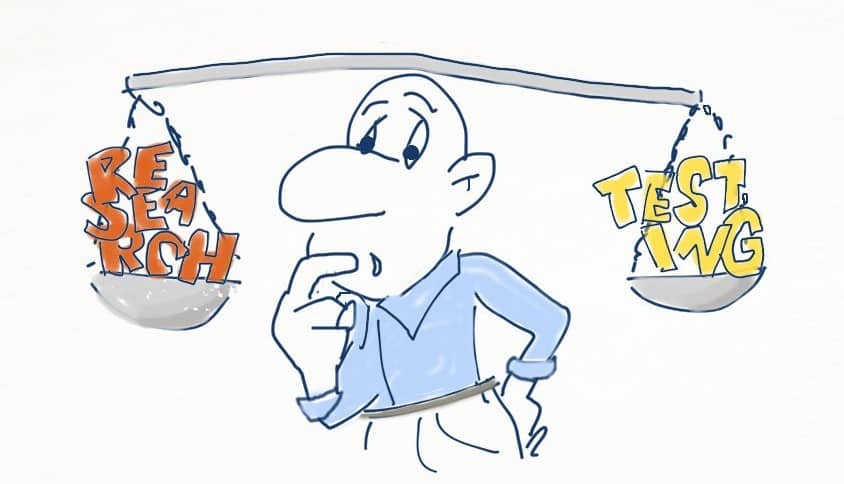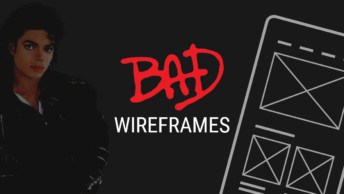How to identify the most useful approach if you’ve only got time for one user-centred-design technique in your project.
My first foray into user-centred design was limited by an inflexible design process and the project budget was already a concern for my client, but I still wanted to try some of the user-centred design methods I’d read about – user research and testing the design. If I could only pick one, which would it be?
By definition user-centred design (UCD) is characterised as a multi-stage problem solving process that not only requires designers to analyse and foresee how users are likely to use a product (using interviews, workshops, analytics, and task analysis, etc), but also to test the validity of their assumptions with regards to user behaviour in real world tests with actual users (testing impressions, functionality, usability, accessibility, performance, etc).
Does one of these take priority? Is it better to learn the needs and set the goals upfront, or iteratively refine the end-result with testing?
It depends.
The scope required for these two broad UCD approaches and the things you’re looking to get from them will depend on the characteristics of your project:
- What the product is
- How big the project is, both in workload and cost investment
- Whether the project is a new design or a re-build
- Whether you’re using off-the-shelf components or building from scratch
- Your ability to influence the project brief or the choices used for the solution
- What skills or experience you or your team are most lacking
- How much time you have before interface design needs to start
- How well you know the users and business, and their respective needs
- What your design and development process is
You’re probably already doing some UCD practices, so look for how you can build on these or fill in the gaps between them. So, how do we pin down these juicy bits?
Working out where the value is
Designing for a good user experience has implications that go far beyond usability, visual design and physical affordance. As UX designers, we orchestrate a complex series of interactions. We follow an objective process that helps identify the sweet spot between user needs and the business or internal goals of the project, and launch from there to design something delightful.
That makes it a powerful tool for adding value, so it’s essential to know which is the pointy end of the technique we’re wielding.
When UX techniques are applied well, they can:
- Be used to confirm or inform things we already know something about – a green light for a certain direction, or a small course correction
- Provide insights across the whole product, so the user comes away with a better net experience
- Plug holes or uncertainties in our team’s experience or skill set
- Provide an objective process when there is a lot of money or reputation riding on the outcome
On the other hand, if we accelerate in the wrong direction we’re going to make a bit of a mess. We should avoid UX techniques where they:
- Repeat exactly what we already know, without adding something extra
- Are very time intensive or expensive in relation to what we’ll get from them
- Give us feedback about the things we have most control over
- Are only going to give us quantitative information without knowing why it is important or how to interpret it
- Distract us from focussing on the core issues of our project
- Cause us to rely on assumptions or use inaccurate data
- Are inordinately focussed on a single aspect of our project
Hopefully you can see where the relative benefits of either user research or user testing will be good for your project. Let’s look at how they might be applied.
Some possible approaches:
Some methods rely on input from others. If you plan on skipping these pre-requisites you need to be careful with using assumptions instead of the real data.
User testing is a useful way to correct any errors along the way, but your project can also benefit by knowing the goals you’re aiming for and getting solid user inputs before you’ve committed time or money to a design. Similarly, using only one method will result in a one-dimensional view of the problem. One is arguably better than none – as long as you choose something that is going to add value for the project.
Neither user research nor user testing are single techniques in themselves. They each cover a range of techniques; some that can be applied relatively quickly and cheaply. Here are 10 UCD techniques that can add value to your project in under 1 hour each:
- Guerilla usability testing – head down to the local pub or cafe, or set up an online user test using Loop11, UserTesting.com, TryMyUI, IntuitionHQ or one of the many others.
- Talk to some real users – spend some time on the support phones, visit forums, add a live chat tool like Olark or SnapEngage to your site, find the weak points in yours or a competitors system, but don’t create a whinge session. Capture their needs – don’t just build a product that you think will solve their problem.
- Interview users by email – users don’t always mean what they say or say what they need, and often prefer to make themselves sound good when writing. However, you’ll get some interesting insights, and won’t have to transcribe any audio.
- Benchmark your competition – create a spreadsheet and track 10 aspects of your 3 main competitors while looking for opportunities. Good for appropriating ideas and learning what users might expect from your site or app, but be very careful of making the same mistakes your competitors are.
- Add Google Analytics and/or ClickHeat to an existing website and look for where users are having difficulty. Fix it up, rinse and repeat over time.
- Coffee meetings / lunch-room chat – have an informal meeting over a hot beverage to get input from stakeholders. Good for politically charged situations, learning about the organisation, and building relationships.
- Create a Wufoo survey or add Get Satisfaction to your site and post it out to social networks.
- Find some web standards and best-practices to read up on, and do an heuristic analysis of your existing site or app
- Use secondary research from Forrester, Nielsen, NN/g or your national bureau of statistics to back up your user comments.
- Create a design concept wall – stick some A3-size design work on the wall of a hallway and ask your colleagues or your clients co-workers for feedback. This helps socialise the designs, and gets lots more perspective.
With my first user-centred design project I realised that doing three small things would be better than doing one large thing – it allowed me to triangulate for a clearer picture, balance out risks and manage the project throughout the design process.
Introducing UCD practices doesn’t have to mean added expenses or delays to your project. I’m not encouraging you to underfund and overstress your UX process – I think it needs good time and money to do well – but applying UCD doesn’t need to be ‘all or nothing’. If you’re wavering, my ultimate piece of advice would be to just jump in and have a go. It’s easier than you probably think!
How have you integrated a user-centred design approach into your smaller projects? Which did you find was the most important UX technique?





